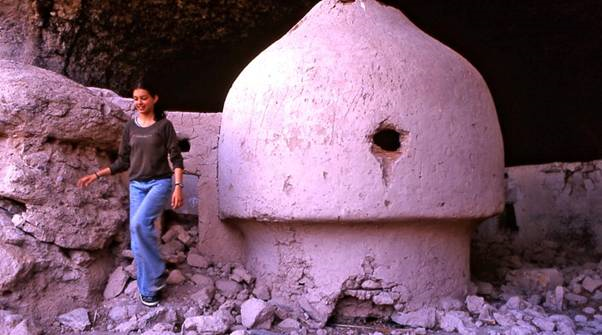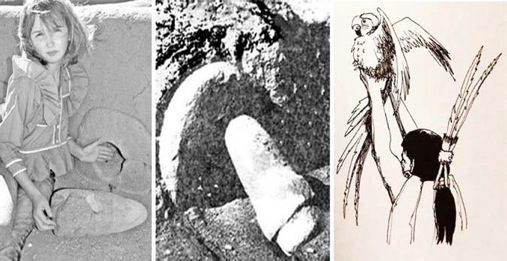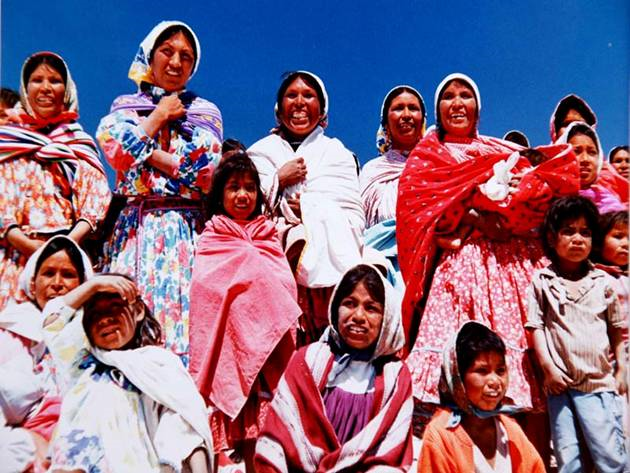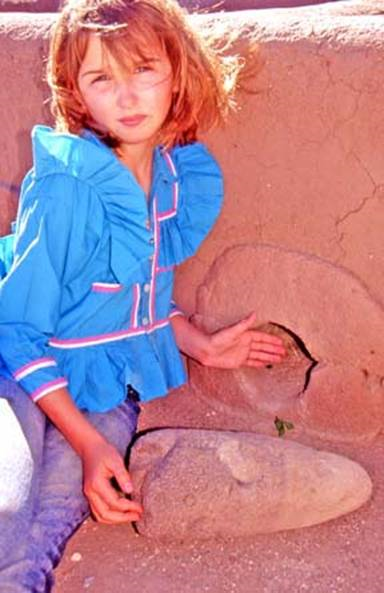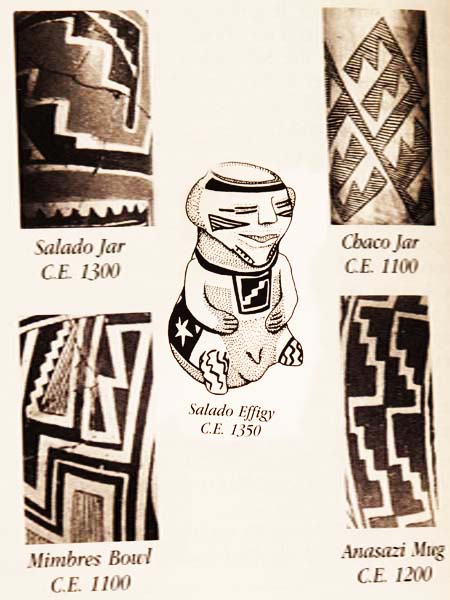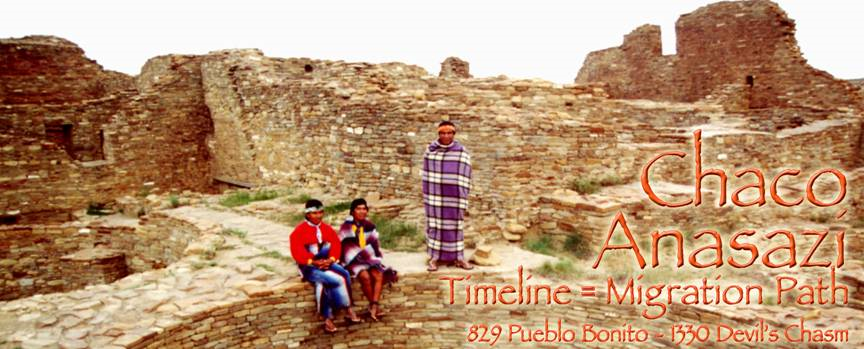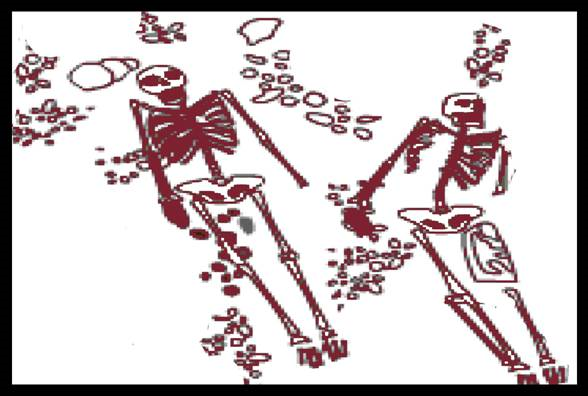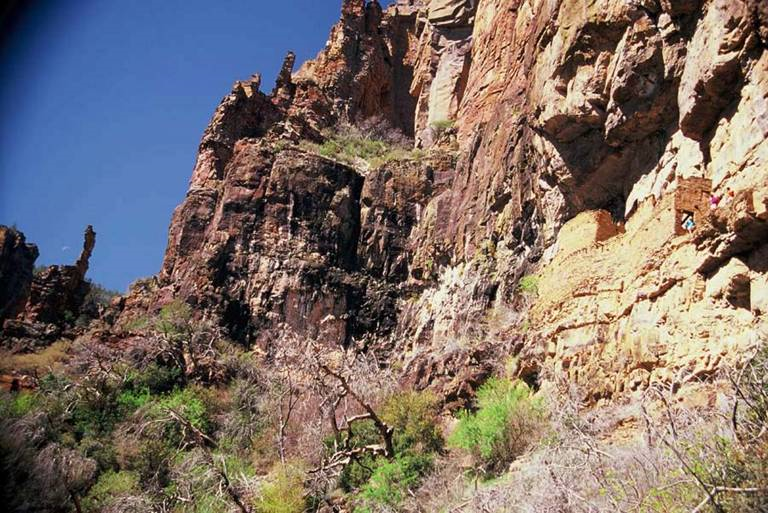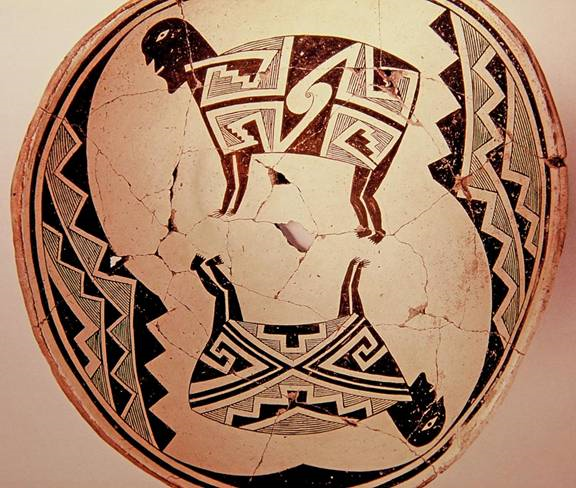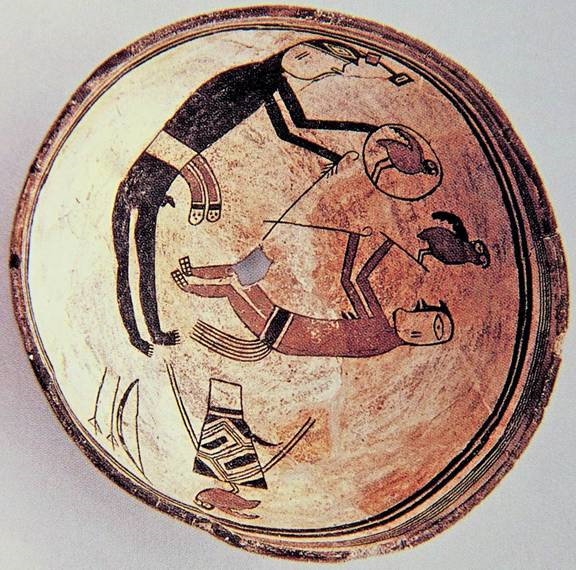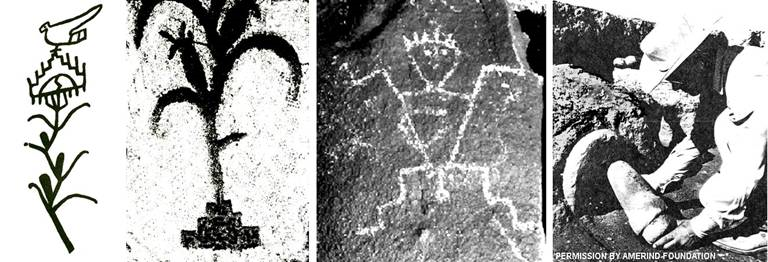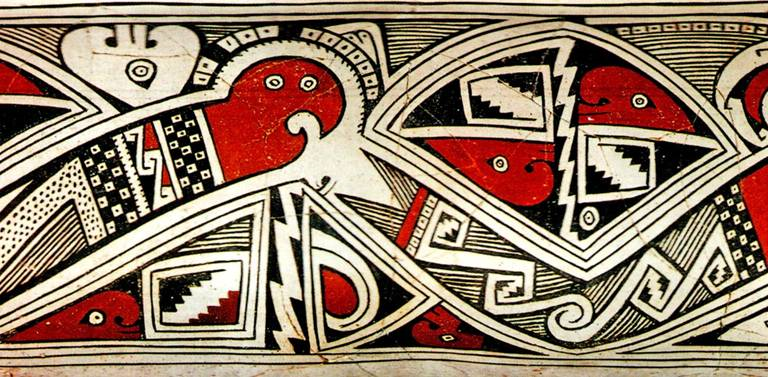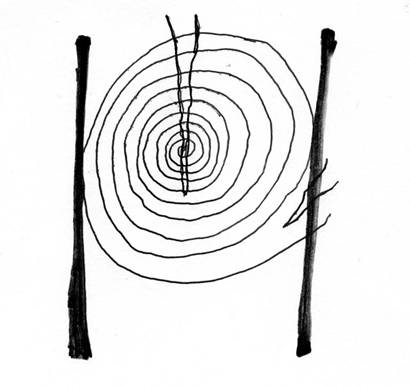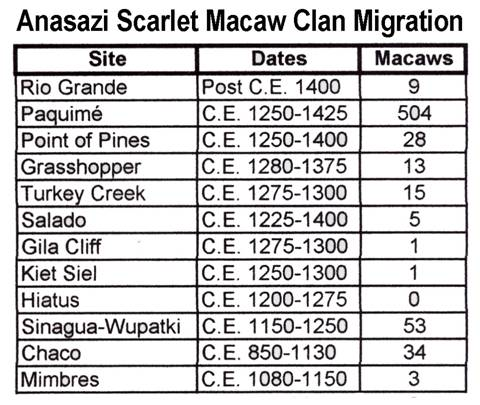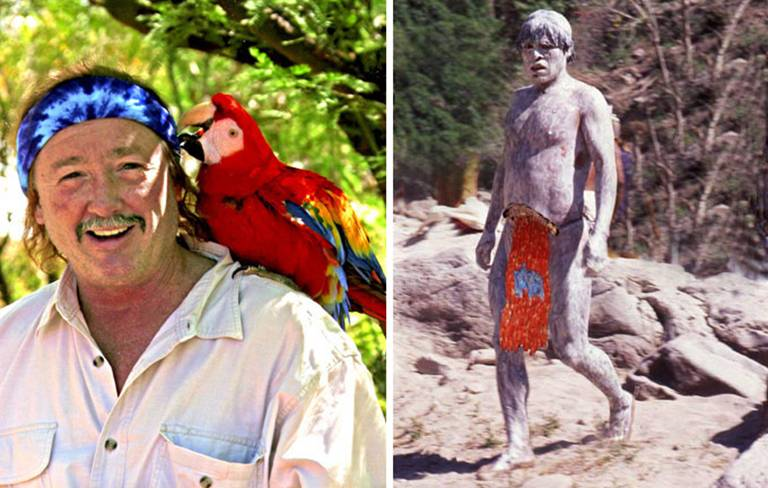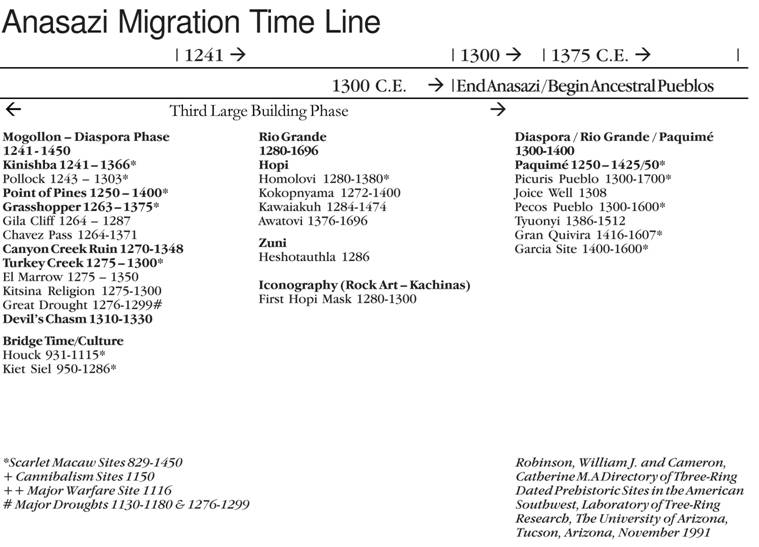The End of Anasazi Archaeology Why Not?
What is the simple Anasazi riddle that can not be answered? Is it possible that Anasazi archaeologists of this generation will never solve any of the age old mysteries surrounding the Chaco Canyon Anasazi and all the descendants of the Scarlet Macaw Clan down to and including Paquime? Is the Lewis Binford Theory the reason for these failures for not modernizing Anasizi knowledge as the no longer new DNA science is widely used worldwide but not for Anasazi origins and migration questions?
These granaries of the northern Sierra Mare were of the Paquime Culture, Currently the evidence suggests yes, the Binford theory is responsible for keeping modern DNA science from addressing the fundamental Anasazi questions. Why indeed is scientifically based archaeology of the Anasazi, Hohokam and Paquime mega complexes stopped in it's tracks years ago and is moving backward as this is written? Is this field of archaeology well behind world wide Archaeology by more that 50 years at this point due to a complete ignorance of Anasazi DNA and lack of any movement in that scientific research direction? The artifacts of this era of Anasazi and Paquime Native American pre-history and the first 100 years of archaeological excavations are today held in contempt and virtually without any level of comprehension or understanding. The entire field of Anasazi Archaeology has now been rewritten to pacify, ignore all historical research that does not agree with the "dogma" and indeed discount all archaeological artifacts, ceramic design as well as the physical monumental architecture itself. This one "Scarlet Macaw Stone" Paquime artifact pictured below, like many thousands of other artifacts dug directly from the ground by professional archaeologist, completely discredits Binford's theoretical proposals. This unchallenged theory has no application what so ever to Paquime or the Chaco Canyon Anasazi. Has the Binford theory become today's Anasazi archaeological dogma and as such has it virtually destroyed the field of scientific Archaeology and all forward scientific progress since the 1960's?
dog·ma (dôgm, dg-) n. pl. dog·mas or dog·ma·ta (-m-t) 1. A doctrine or a corpus of doctrines relating to matters such as morality and faith, set forth in an authoritative manner by a church. 2. An authoritative principle, belief, or statement of ideas or opinion, especially one considered to be absolutely true. See Synonyms at doctrine. 3. A principle or belief or a group of them: "The dogmas of the quiet past are inadequate to the stormy present" (Abraham Lincoln). [Latin, from Greek, opinion, belief, from dokein, to seem, think; see dek- in Indo-European roots.] After 100 years of intensive study archaeologist are unable to explain how,where and why the Anasazi migrated. Equally so many other mysteries remain such as the meaning of the dominate ceramic design patterns, did they make and drink corn beer and how does the bone record reveal why they, for the most part, disappeared. Why, Why, Why? The simple answer is the 50 year Binford mis-application to the Anasazi Theory Wars. Now the complete victor can be proclaimed in the past decade and that is the Binford Theory cum dogma today. This theory is totally unsuited to any of the Anasazi questions and the entire system of incorrect archaeological proposals can be set straight by using the accepted science of DNA analysis. Mis-application, simple as that. In short, archaeologists have abandoned all the Anazazi cultural artifacts unearthed by actual excavation in favor of a dogma or overarching "theory." What is this mysterious and powerful dogma and who dreamed it up? Lewis Binford - his theory and Biography Lewis Roberts Binford (born 1930) is an American archaeologist, known as the leader of the "New Archaeology" movement of the 1960s. Binford's contribution to archaeology was as much on the theoretical as on the practical side. He advocated the concept of processualism, which argued that no site could be truly understood without an understanding of how it had been created, the corollary being that any excavation or archaeological investigation should begin with a theory against which the evidence could be tested. His 1962 article, "Archaeology as Anthropology" (American Antiquity, 28: 217-225) effectively began a new movement in archaeology, beginning from the "Old Copper Problem". In the process of analysing the use and exchange of copper artefacts in North America, he developed a theory about the development of cultures which was as much anthropology as archaeology. From Wikipedia Lewis Roberts Binford (November 21, 1931 April 11, 2011) was an American archaeologist known for his influential work in archaeological theory, ethnoarchaeology and the Paleolithic period. He is widely considered among the most influential archaeologists of the later 20th century, and is credited with fundamentally changing the field with the introduction of processual archaeology (or the "New Archaeology") in the 1960s. Binford's influence was controversial, however, and most theoretical work in archaeology in the late 1980s and 1990s was explicitly construed as either a reaction to or in support (in the case of the Anasazi and Paquime) of the processual paradigm. Recent appraisals have judged that his approach owed more to prior work in the 1940s and 50s than suggested by Binford's strong criticism of his predecessors. In brief, this applies to the Chaco Anasazi through to Paquime Mesoamericans as the driver of virtually all of the "Anasazi Theory Wars" starting with the "Chaco Project" 1971 to 1986 and continuing today with the Paquime Conference in Dragoon Arizona in 2013. Binford's theory cum dogma as incorrectly applied to the Anasazi, can be described as "in situ incremental evolution" of every Anasazi, Hohokam, and Paquime site as the archaeological records are systematically being rewritten to conform to this theory/dogma and any suggestion of migration, religious change, conflict or warfare written out. This quote by Binford apples precisely, "change in the total cultural system must be viewed in an adaptive context, both social and environmental, not whimsically viewed (as) ... influence, stimuli and migrations between and among geographically defined units." 1962 This statement, theory and now dogma came out of some arguments concerning an ancient copper axe discovered by an archaeologist in the western Great Lakes region and had nothing what so ever to do with southwestern archaeology and nor the Anasazi. According to Wikipedia, "Binford did most of his work with low density Archaic hunter-gather early societies where there is little change over thousands of years and are relatively consistent in terms of artifacts worldwide." Bingord's theory is very misplaced with rapidly evolving, migrating, complex agricultural societies such as the Anasazi, Hohokam and Paquime so close to very advanced societies proceeding step by step south along the Sierra Madre to central Mexico's great cities and civilizations, some of the most complex societies in the world at that time. Binford and colleagues give a warning to future archaeologist. A note for this publication and challenge is that I attempted to interview Binford personally over the years and present to him the current Chaco to Paquime migrations conundrum to see what his perspective was on this question. Unfortunately he had passed away before I could track him down. Now skip forward to 1971 and the "Chaco Project." The "Chaco Project" was conceived by Dr. John M. Corbett in 1969 to review and codify the archaeological findings for the Chaco Canyon Anasazi. Notice the date progression and geographical relationship relating to Binford and the Chaco project. This "Chaco Project" had numerous fascinating and varied out comes but perhaps the most important was to codify (dogma)the "Binford theory" for all Anasazi archaeology. That is essentially "in situ evolution" development and collapse of each and every site in the southwest and northern Mexico. Binford worked as a professor at the University of New Mexico from 1969-1991, well placed to influence the trajectory of Chaco Anasazi Theory through the Chaco project if nothing else. The 2013 conference at Dragoon is seeking to do the same for Paquime, in the modern era. That is to apply procedural archaeology and revisionist pacification theory, incorrectly, to a clearly Mexican site with Anasazi migragion and Mimbres influences, oil and water. The facts of Paquime in no way fit Binford's approach, theories, or musings cum dogma. Another outcome of this theory war in applying the "Binford Theory" is that the modern archaeologist must discredit the finding and theories of the now retired or passed on archaeologist, who actually did virtually all of the original excavations. There are many specific, widely know and accepted facts, dug from the ground, that fly in the face of applying Binfords theory to the Anasazi, Hohokam and Paquime cultures. The modern Gravy Train - a completely modern imaginative invention that controls Anasazi archaeology today. Why is the Binford dogma so powerful? 2. Binford was a good talker. He spoke in such complex jargon that only those who are highly education in the field of anthropology could understand what he was saying, thus he personally appealed to the elitist closed society we see controlling all discussions and prevention of using Anasazi DNA research from taking place. 3. It is a modern "gravy train" for those who make a living from Anasazi Archaeology today. For those professionals in the field, jobs and publishing funds are only available for those who are mainstream Binford proponents. Perhaps this is the only opposition ever published challenging the Binford dogma and is only available on the Internet. There are many, perhaps hundreds of professionals who I have personally interviewed who object to the Binford dogma but they are publicly very quiet. Most of these are from the past generation and who actually did the origional excavations. Equally, perhaps, many if not most probably are unaware that the Binford as a theory has now become the unchallenged dogma. My answer is simply, Chaco and the rest of the Anasazi are a late stone age culture yet complex agrarian society. If one can not explain this culture in the terms that the Chacoans themselves could understand then Binford theorist, using Binford's own words, "have nothing at all." Can this be correct, "nothing at all" to explain the massive Anasazi, Hohokam and Paquime culture in the deserts and mountains of the basin and range regions of the American southwest, a million square miles and 600+ years of human history?
Archaeology as Anthropology - Tarahumara women have complete control of the food economy. Can this also be correct for the Chaco Anasazi Scarlet Macaw Clan through their timeline of migration? The Tarahumara are know to be a very strong fighting yet peaceful tribe. This is first class anthropoligical evidence and can be applied to Paquime and the Chaco Canyon Anasazi as well. A completely new possibility that the carrot of food and not nesessarily the stick of conquest can be applied in the Anasazi/Paquime question. That Chaco building could have also been paid for by food as well as corn beer which is how their Tarahumara pay for virtually everything in their own culture. In 1450-1600 C.E. the Tarahumara territory overlaped the Paquime cultural region substantially around the modern town of Madera, Chihuahua and the canyons to the west where the first Paquime granaries were discovered. It cannot be that complex. The Tarahumara tribe understands today that food dominates the entire landscape; religious, environmental, social and geographical. In plain English it is the, earth sciences, as applied to late stone age culture of the American southwest. If one does not deeply understand late stone age agriculture, in Binford's own words, " it is nothing." The Tarahumara agrarian culture of the 1980's-90's relating to the Chacoan's of the 800's-1200's, is about as "anthropological" as it gets (Professor Binford). 1. Mexican Migration Theory the first Anasazi theory dominate until the 1960's. New evidence today indicates that this is the most solid scientific grounds available until rigorous DNA research on a massive scale is done. It should be done in Europe where there is a long and successful history of human DNA testing regarding human origins. All Mexican DNA studies should be sent to Europe to the: They do not have a bone in this fight and will give the best reliable answers without theoretical bias and most importantly Mexico and send their Paquime DNA evidence to them for answers important to Mexican Archaeology! This will put Mexican Archaeologist at the top of the field internationally and lead the field of Paquime, Mexican Archaeology for the first time. And if needed the Max Planck Institute may help with funding. This one action will put the Mexican archaeologist at the top of modern archaeology worldwide. And just as importantly, open the door to a whole new field of Mexican archaeology from the Maya all the way to Paquime. DNA will open a whole new field, lots of jobs and resolve thousands of questions concerning more than a dozen ancient advanced civilizations that built monumental architecture in Mexico. How are they all connected? Did Clans migrate, who is related to who? Thousands of major questions answered, thousands of new questions and a whole new world for Mexican archaeology. In so many fields including Archaeology, Europe is the new way forward. Incredibly exciting! 2. The latest and biggest joke in the history of Anasazi Archaeology is the theory of: Following on with an anthropology observation these publications are paid for by US Governemt funds borrowed in part from the Chinese in the first decade of the 21st century! How interesting is that modern cultural fact as a modern Anasazi archaeology related fact? Peer Review process today is completely decimated. Closing this huge can of worms is the observable fact that the "peer review" process is completely and irrevocability crushed by the Binford theories florence in the professional field of Anasazi archaeology, today. Peer review is completely non functioning across the field. 3. "Cannibalism, Political Control and Terrorism" theory. Cannibalism is one of the only things "proven." "Terrorism and political control" no factual basis at all in the artifact record or in southwestern Tribal anthropology. As far as the Cannibalism evidence is concerned there is no evidence at all as to who ate who, why or under what conditions. But DNA testing of the dried human waste that proved cannablaism may be able to give evidence of who ate who in that one case anyway. HA! How beautiful is that? "Terrorism and political control" is well beyond the pale of any scientific evidence, anthropological records and what is widely accepted and known about historical Puebloan groups. There is "nothing" for terrorism or political control. 4. Drought and Little Ice Age theory no basis at all. 5. Fallow Valleys - some merit if it applies to wildlife, anemia and lack of dietary iron. 6. Agricultural, fundamental Religion change and Migration Theory. This research first began in the late 1990's with the "discovery" of a system of granaries in the northern Sierra Madre and followed on for the next decade by uncovering the migration path of the "Scarlet Macaw Clan" from Chaco Canyon in 3 major phases to Paquime. This theory is the one most likely to be supported by DNA research today. A few examples of revisionist pacification theory at Salmon completed in 2008. Beyond Salmon, Chaco, and now Paquime this theory has been appliend to virtually each and every site. Google: Snaketown Hohokam and see if you can spot the revisionist pacification and in situ rise and fall of that major cultural site over a claimed 600 year period. This is the application of the Archaeology as Anthropology of Binford application of dogma to all Anasazi, Hohokam and Paquime sites. Example #1. At the end of its occupation in the 1280s, much of Salmon Pueblo was intentionally burned. Several rooms on the western side of the Pueblo contained bushels of corn that were consumed in the fire (Reed 2008b, p. 19). On the burned roof of the Tower Kiva in Salmon's central roomblock, nearly 20 children and several adults were partially cremated at the site's abandonment. This event was originally interpreted as an act of warfare, with the deceased killed as a result of the fire. However, more detailed, subsequent analyses (application of the Binford dogma) have revealed a much more complicated situation with the final cremation of the individuals at abandonment and little or no evidence for warfare (Akins 2008, p. 140-164). (in part from Wikipedia) Example #2. El Morro by Stephen A Le Blanc "One of these pueblos, it turned out, had been burned to the ground; its people had clearly fled for their lives. Pottery and valuables had been left on the floors, and bushels of burned corn still lay in the storerooms. We eventually determined that this site had been abandoned, and that immediately afterward a fortress had been built nearby. Something catastrophic had occurred at this ancient Anasazi settlement, and the survivors had almost immediately, and at great speed, set about to prevent it from happening again. Thirty years ago, archaeologists were certainly aware that violent, organized conflicts occurred in the prehistoric cultures they studied, but they considered these incidents almost irrelevant to our understanding of past events and people. Today, some of my colleagues are realizing that the evidence I helped uncover in the El Morro Valley is indicative of warfare endemic throughout the entire Southwest, with its attendant massacres, population decline, and area abandonments that forever changed the Anasazi way of life." Steven A. LeBlanc is director of collections at Harvard University's Peabody Museum of Archaeology and Ethnology. What happened to his on the ground archaeology analysis? Application of the Binford dogma across the Anasazi field of study. Example #3. Paquime - From the evidence of the original excavation 2 related facts are the clue. The Scarlet Macaws and Turkeys were left in their boxes to rot. And later the site continued to be inhabited on a much reduced and more primitive scale. The site was subdivided into smaller units with flimsy walls and burials were made in the water intake canal and exiting sewer. What conclusion do these facts leas to? a. The Macaws were in their pens, so that would be on the spring equinox March 19 - 23. Scarlet Macaws were the single most valuable item the the Paquime people possessed. b. Turkeys would certainly would have been eaten not left in their enclosures to rot. Food, especially protein, was at the top of anyones needs on a daily basis. Turkeys are relatively easy to carry and could be counted on to live for weeks or even months while on the march if given a little bit of mashed corn and beans on a daily basis. c. Paquime was attacked and partially burned according to Di Peso, the original "boots on the ground" archaeologist. So how is it possible to propose a steadily declining habitation of the site? d. The primary priest, chiefs and warriors were the targets and killed during the initial attack at the ceremonial time of the spring equinox (March 19-23) around 1400 and the remaining residents scattered to the safety of the near by hills or back to the numerous outlier communities. The primary targets were the high ranking Scarlet Macaw Clan leaders, and their religious practices, no the general population. e. The returning people were stragglers and squatters who re-inhabited the place when the Scarlet Macaws and Turkeys were stinking or already decomposed and left them undisturbed in those pens. f. Over the next decades the sturdy walls and remaining roofs provided for a much diminished population of elders, women and those not willing or able to make the migration to perhaps the Culican region to the southwest. (DNA testing of human remains can answer this question. There is no prohibition to DNA testing in Mexico and no objections by the native tribes there.) g. At last, decades later, the site was used as simply as a temporary refuge durning harsh winter storms. Even as just a harsh weather refuge, over decades, there would be a relatively substantial amount of material artifacts left behind on or near the surface and graves conveniently provided by the unused and slab covered water/wastewater canal. h. Some of these same reuse features are also seem at Chaco, Mesa Verde and other major sites where the extremely sturdy architecture provided protection from extreme weather, especially cold, for decades and perhaps several generations after the primary population had migrated. This reoccupation left behind a substantial amount of material goods on the surface that provides evidence such as people living in small round rooms at Mesa Verde which were originally corn granaries and meat smoke houses for preserving food. Evidence of this is clearly visible in the archaeological record at Paquime as well. i. That is why the carbon 14 dating must be done on the Scarlet Macaw bones left in the chambers a Paquime. That will give the closest possible dates for the last Paquime Scarlet Macaw Ceremony. My estimation is Paquime as attacked around 1400 on the spring equinox March 19-23 , with squatter rehabilitation up until about 1450. j. DNA testing on the Paquime Scarlet Macaws will be able to provide comparisons to Scarlets found in Mimbres, Mogollon, Wupatki and Chaco Canyon itself. DNA testing will also answer questions about breeding programs, if any, and origins of the original birds on the west and/or east coast regions of Mexico. The final analysis is that Binford Theory may apply to an argument over an isolated copper Axe in the remote and culturally isolated Great Lakes region it has no validity what so ever to the Chaco, Hohokam and Paqime peoples. These three ancient cultures are so geographically close and culturally associated to central Mexico as evidenced by the archaeological facts, Spanish historical records, Hopi oral history and in fact even modern Tarahumara lifestyles, religion and agricultural traditions that the currently completely victorious revisionist pacification theory is without any merit what so ever. Paquime is the Binford anti-virus. The evidence now provides that Paquime was founded by the Chalchihuites peoples because it dates from the time Chalchihuites was abandoned 1200 and Paquime founded 1250, both sites were primarily constructed from adobe in contrast to tabular stone of La Quqmada and Chaco. Most importantly "Macaw Stones" were discovered in the early 2000's at Chalchihuites in Mexico.
A new generation is at hand. This "Scarlet Macaw Stone" can
not explained by the Binford dogmagist The "Macaw Stones" are extremely rare in style and shape and there for a unique cultural marker which are only found in Paquime and Chalchihuites. If nothing else this one archaeological artifact alone disputes the entire Binford dogma for Paquime. There are thousands of such examples in fact. Other significant notable exceptions that have absolutely no cultural context anywhere else north of modern day Durango Mexico are House of the Well, House of the Skulls and House of the Dead at Paquime. The (authentic) ball court, a half dozen sculptured ceremonial mounds as well as cisterns and a covered sewer system can not otherwise be recognized any where else in the northern Anasazi archaeology nor modern Puebloan anthropology. End of the line for the Anasazi Scarlet Macaw Clan That is the month and day(s) Paquime is burned. Pre-dawn March 21, between 1400-1450 C.E.. The sun did not rise for those Scarlet Macaws ever again. Equally the Anasazi/Paquime, Scarlet Macaw Clan never recovered from that catastrophic attack although some may have lived in he ruins for some time there after as indicated by the evidence excavated at Paquime in the 1950's. The year dates comes will from the burned beams along with the Macaw bones in the cermonial birthing chambers which are in an open air plaza. The Macaws are only in those ceremonial birthing chambers on one night each year , March 19-21th, carbon dating will establish with in a range the closing date between 1425/1450. The birthing chambers have a adobe closed solid top and are round barrel type structures with no top. The only acces was that 8" to 10" phallic-yoni hole. Just large enough for the birds to squeeze through. (The modern, open top restoration is incorrect.) The birds could not turn around in the chamber nor be accessed through a top. If they were in there very long at the feathers would be shredded as the birthing chambers are too narrow for the birds to turn around and zero vertical clearance. The brilliant red feathers were the most valuable part of the birds and symbolized the Sun to the Anasazi Scarlet Macaw Clan. The Tree top dwelling Macaws were also on the ground so no breeding nor healthy life inside possible. The birds would die with in a week. No exercise, cleaning, food, nor water access available in the cramped barrel chambers. On March 19-21, mid-spring, some female birds would still have held the matured eggs internally. So a few eggs might have been found well preserved and in the barrel chambers. The Vernal Equinox, March 19-21, is a stable date each year. If one can find the carbon 14 date of the burned beams then you can find that Paquime was burned March 21, 1400-1450 year or range of +/- 20 years. The University of Arizona in Tucson has the carbon material from the burned Paquime beams in their tree ring lab for testing. Those are the basic facts available from what is already known today. One can surmise that the most important festival in the Paquime religious calendar was the Vernal Equanox. It could be expected that the attackers know that all of the Scalet Macaw Clan members would be in attendance at dawn on that day from the surrounding communities. An attack on that day would totally unexpected and the attackers would expect to catch and klll many if not most of the Scarlet Macaw Clan at Paquime on that fateful day. End of the line for the Scarlet Macaw clan and the Chaco Anasazi descendants in the American southwest. End of an era, March 19-21, 1400-1450 for the Anasazi. Now all that needs to be done is for the U of A scientist to do the carbon 14 dating. You can observe for yourself that there is no way that the large mature Scarlet Macaws were born in these very small chambers. The chambers are so narrow the birds could not even turn around with out damaging their feathers. The Red Macaw feathers were the only value of the birds to this culture. Why were the Scarlet Macaws found in here during excavation? Because the were in those cylinders during the Vernal Equinox Cermony. The Scarlet Macaw is 32-36 inches long including the tail, about 4-5 inches wide and the average weigh is 2-2.5 lbs. The body is about the size of a loaf of bread plus the tail. The door of the ceremonial birthing chambers would barely accommodate this Macaw and the interior is only slightly larger. There were no removable tops on the barrel shaped ceremonial birthing chambers. No access for cleaning, water or food. No room for the large sized Macaws to move nor turn. The chambers are placed in direct contact with ground, Mother Earth, and were "birthed" on March 21 at the Vernal Equinox, the day the sun is "reborn" again each year. This we know from the evidence clearly observable. We can surmise that the barrel birthing chambers would be opened at dawn on March 21 and Macaws would voluntarily walk out eagerly into the hands of their individual handlers to greet the rising sun. All of this can be predicted from modern Scarlet Macaw behavior observable in today's work, given the archaeological observable on Paquime's excavation. The scientist of that time knew nothing of Scarlet Macaw behavior nor Anasazi/Paquime religion. Even today, in professional archaeological circles an "expert" on Anasazi/Paquime religion cannot be located by this researcher. Thanks to Bill Gates and Steve Jobs you can learn it here first on the internet and it is free!
The Binford theory has no explanation for Anasazi ceramic design after 50 years. Why is this? Because the Binford dogma "has nothing" for Anasazi Archaeology. The meaning of these symbols is the "religion" of the universal male/female relationship of truth of all things a carried by lightning sky to earth union. The male is high redundancy, low entropy, complex and rigid hierarchy, and competition. The female is egalitarianism, flexibility,female participation, dampening competition and conflict, high entropy, low redundancy, and emphasis on feeling, empathy and spontaneity. So you want to do some Archaeological Research yourself? You have always wanted to look into an archaeological mystery about the Anasazi/Paquime people? Try researching the contents of House of the Well and House of Skulls from Dr. Charles Di Peso's Volume 8. If you can find the meaningof the contents of these structures you will make archaeological history. You can do it all from you comfort of your living room easy chair so why not?
Advertisement - Anasazi Anaemia Since no research outside of Binford Theory is ever considered under any circumstances, I am going to use this young native woman with a Scarlet Macaw on her shoulder to catch your attention. Lovely young woman are often used in American advertising. Anaemia is the driving force behind Anasazi migration and eventual abandonment of the Southwest and northern Mexico in 4 stages. This is well recorded and documented in the Anasazi bone record. Since the Anasazi had no domestic animals that ate grass, over a 200 year time period, they exhausted the local wildlife resources and the began to succumb to anaemia, especially in young female deaths during childbirth.. This photograph is a special gift of enlightenment and joy for the Binford theorists, who are working in their stodgy and dusty museums on a theory that is a complete deadend.
Anasazi Scarlet Macaw Princess
A special gift for the Binford theory people. "I am wearing my friend face headdress. My headdress represents the Scarlet Macaw Clan who are predators.. You can take my DNA if you desire it... but I will likely eat your heart. See you soon darling!" Mary CapTiva
P.S. Scarlet Macaw DNA has been done since at least pre 2001. Are you Binford guys a little afraid of we little Anasazi...girls? If so, I can tell you that we call our Scarlets "finger biting off parrots." So be very careful sweetheart! Our parrots love blood just like we do. Only we, especially lades, need it for our Anemia, which often kills us during childbirth.
Female athletes and iron deficiency (anaemia) http://www.pponline.co.uk/encyc/female-athletes-and-iron-deficiency-anaemia-752 How to iron out the problems of anaemia As we've already indicated before at Peak Performance, iron problems and female athletes are as closely linked as Westminster Abbey and Big Ben. In Great Britain and the United States, about 30 per cent of adult women and 40 per cent of adolescent women are iron deficient, while around 6 per cent of both groups suffer from true iron-deficiency anaemia. However, studies of athletes report higher frequencies of iron problems; Anasazi bones and studies indicate extreme anemia in all groups but indicate also exceptionally high mortality in child bearing age women. Again this is well recorded in the Anasazi bone record as anemia is clearly indicated by the bones.
Prologue As a youth I had a romanticized view of Native American western history that was intertwined in my mind with the biblical old testament tribal historical saga. In my fantasy leaders like Crazy Horse, Sitting Bull and Geronimo, and Cochise had personalities much like legends David and Solomon, Cain and Able. As a university student I focused on public health which lead me to the understanding of Anemia among the Anazasi much like a biblical plague. I also studied competitive sports which put me in a good position to understand the Tarahumara ultra-endurance racing and the interface with the Anglo-American competitive running community. I was generally interested in the Anazasi as a personal fascination but had no idea or ambition to do more than keep up with current reading on the Anasazi and worldwide archaeological discoveries. In middle age I was introduced to a system of granaries and small communities with T shaped doorways hidden in the northern Sierra Madre that were not known or studied by any archeological professionals. At this point I set out on a journey that would take more than a decade to integrate these Sierra Madre discoveries with the rest of the Anazasi and Paquime systems. I discovered that they had sophisticated systems for producing fertilizer, long term storage of corn and a long distance human transport organizational methods. Equally I found based on Tarahumara ethnographic evidence the meaning of Anazas ceramic designs. From the University of Arizona tree ring lab that all large Anazasi stone buildings fall along a very specific time line that indicates migration on a more or less ten generation frequency. At last I found that where the Archeology is detailed enough that all of these large buildings were created by "a clan" who worshipped Scarlett Macaws and The Sun God on platform mounds. When this research project came to an end in the mid 2000's I was quite surprised that I had developed an unique body of work that was to be found no where else in the Archeological Annuls. I presented it in dozens of museums and universities across the southwest with my Tarahuara companions who helped me understand and comprehend so much of their religious beliefs as well as agricultural lifestyles. Approaching retirement age, I had no idea why none of my work was being considered or looked into. The research was complete and I found that I was satisfied for myself on a scientific basis for resolving entirely all of the questions and riddles of The Anazasi Scarlett Macaw Clan saga. In 2013 I discovered where the missing grave sites were for the Chaco Canyon Anazasi. And also that Paquime very likely closed on the Spring Equinox which is consistent every year because the Scarlett Macaws, the most valuable thing to the Paquime and other southwestern Anazasi groups were abandoned in their ceremonial enclosures. I was waiting for the DNA studies to be published when I found that there were none and none planned, especially at Chaco and Paquime. At this same time I found that the study of the Anazasi DNA, a new science available in the last twenty years, and widely excepted worldwide, can scientifically solve all of the remaining issues. I wondered why this had not been done, and then I discovered the effects of the Louis Benford theory on all of the Anazasi research since the 1960's. Responding to the belief in this theory, which to me seemed like dogma, resulted in a difficult year as I created this website. In conclusion, I discovered how the Anasazi lifestyle worked, but also why it could not be understood. As an older man I feel fulfilled with my life's path and understandings of the Native American ancient cultures. I try on a daily basis to live with passive non competitive wisdom that the Tarahumara Indians and southeastern Asia tribal groups have taught me over the decades. Mostly in isolated quiet comptemplation. Epilogue I have been advised, "we think you shouldn't be so pugilistic or these guys (archeologists) will circle the wagons". My answer is they started circling the wagons around the Binford Theory in the 1960's and completed their victory of the field of Anasazi Archaeology in the late 1990's. My daughter advised me to "take it easy on them" or they will not listen.That is the reason for this web site. They have not been listening for decades. No number of facts or discoveries alter the current Binford theory, one iota. Now the whole world accepts DNA Cold Case Files research, but not the the top Anasazi archaeologist. They can not hear the bell. Someone needs to blow the whistle loudly "game over." This website does this scientifically, respectfully in great detail, and with great irony. GAME OVER! THE SCARLET MACAW CLAN RULES!
Chaco Anasazi Migration and Religion - The New Science The Anasazi of Chaco Canyon and their
direct descendants of Mesa Verde, Wupatki,
Scientific DNA testing is the way forward for Anasazi Migration
The ancient burial in room 33 at Pueblo Bonito is a treasure trove for very productive DNA testing for the Anasazi people. This was a grave containing a man, nine women and an infant. They seem to have been buried at different times and may have been members of the same family. The dead rested on sleeping mats, and several of them were decorated with turquoise ornaments. The main cemetery of the town has never been found, (see below) but small burial sites like this one are common at Pueblo Bonito. DNA will give most of the answers of virtually all of the remaining Anasazi questions of migration, where did they come from and where did they go?
The Anasazi deserve better than the wild theories and unscientific proposals about them circulation today which are for the most part an insult to them as well as the science of Archaeology. (example ancient aliens origins, Kings, troops, tax collectors and inquisitors).
These talented ancients of the Scarlet Macaw Clan at Chaco and their descendants built virtually all of the magnificent stone buildings across the Southwest including San Juan, Mesa Verde, Great Sage Plain, Wupatki, Kayenta, Mogollon, ultimately some for them migrated to Paquime.
Room 33 Pueblo Bonito, Chaco Canyon (above) "Ancient burial room at Pueblo
Bonito. This was a grave containing a man, nine women and an infant. (in part from PBS)
Room 333 Pueblo Bonito, Chaco Canyon "Located on the western side of the pueblo, the room contained between 23 and 32 individuals. An accurate number is difficult to obtain due to the smashed and disjointed condition technically called “disarticulation”– of all but four of the skeletal remains." (in part from Pepper's room 33 and Judd's room 333):
http://www.chacoarchive.org/media/pdf/002164.pdf
- some of the intact remains had filed teeth, - room 333 is also on the west side along with room 33, - can be interpreted as sacrificial burials to the 4 intact individuals? - these rooms bones are an excellent example of the need for DNA testing.
What is the genetic relationship these people? Are they related or not? Perhaps they are an assemblage of Chacoans and their enemies? Many have speculated that some are from Mexico and the others are local but in fact they could be from anywhere, Mesa Verde, Salmon, San Juan or even Hohokam.
The DNA relationship answers to the contents of rooms 33 & 333 will go along way to answering many if not most of Chaco and Anasazi mysteries region wide along the very well documented path and timeline of great stone buildings constructed by the Scarlet Macaw Clan and their descendants.
The DNA from room 33 and 333 of Pueblo Bonito will give answers to virtually all of the Anasazi Migrations questions pre - 829 C.E. back to La Quemada in Mexico. And post 1150 to the San Juan, Mesa Verde, Great Sage Plain, Wupatki, Kayenta, Mogollon, and Paquime. This is the very detailed migrations of the Scarlet Macaw Clan which indeed entered the southwest at Pueblo Bonito at 829 C.E. and departed the region at Devils Canyon in 1330 C.E.
Long Lost Chaco Cemeteries Discovered! by Richard D. Fisher
In another discovery after re reading the original burial reports many high value ceramics and attendant burials were haphazardly dug from "trash mounds." I believe there where not "trash mounds" at all but rather ceremonial platform mounds. These are the long lost "cemeteries" of Chaco that were destroyed by pot hunters in the early part of the century. The basic soil geology of Chaco is sandstone so once the "mounds" were opened the structure just blew away over the next few decades. I believe these platform mounds served the same purpose as those at Paquime, the Scarlet Macaw Clan religious structures. At Paquime the religious mounds basic soil component is an igneous clay which with stands weathering much better. In addition Paquime is about 500 years younger than Chaco so the mounds survived into the modern era in much better condition than those of Chaco.
It is time for Southwestern "Ancestral Puebloans" Archaeology to evolve out of the stone age and join the modern science of Archaeology on a respectable footing with the likes of Egyptian and European lineages which are well documented scientifically and DNA connections very well recognized worldwide today. No more disrespecting these incredibly talented ancient Americans by superstitious self serving musings and the bad science of non Natives.
Give this Scarlet Macaw Clan lineage the science and respect that they are due.
Fajada Butte Natural Chaco Pyramid Discovered! Discovered by Gary David
...relates to the ethnographic reports of a witch renowned for her practice of holding human hostages atop nearby Fajada Butte.
Along with the Burial Platform Mound Cemeteries also discovered from re reading the original archaeological reports of excavations, this is a major break through for understanding the ancient Chaco Anasazi.
Where did the Chaco Anasazi come from and where did they go? Just do the DNA!
There is no building even remotely similar to Pueblo Bonito prior to 829 C.E. north of La Quemada, Zacatecas, Mexico (650-900 C.E.) and no Scarlet Macaws at all before 829 in the Four Corners region. Additionally the Chaco Anasazi were unique in that they held their religious ceremonies on platform mounds, fumigated and stored their corn in above ground small "smoker" round granaries, had large round communal kitchens or breweries such as Casa Rinconada (a screened platform mound), and dehydrated natural fertilizer from the cryptobiotic soil blue green alga in a system of shallow plastered basins. For serious archeology students the internet is the
future for researching the Anasazi Migration and all other Anasazi questions
going forward. The last major update for the Anasazi Migrations originally came from Charles DiPeso in the 1950s relating to the Kayenta Anasazi. A few theories and minor revisions have been floated in the past 60 years but nothing of real significance that stands up to scientific scrutiny has stood the test of time, until now. Who were the Anasazi? Much has been debated but the obvious answer is the best one. They are the linage that built all of the great stone and timber buildings across the American southwest. They started at Pueblo Bonito in 829 and the neighboring 3-6 neighboring Great Houses. All stone Great House and cliff dwelling builders are descended from this original group of clans as demonstrated by the tree-ring data graph provided below. As far as is know this is the only such graph ever compiled and is completely original to this work. This graph makes it possible propose a completely new "Unifying Theory" for everything to do with the Anasazi. In short there was nothing like Pueblo Bonito and it's neighbors before and this cluster of Great Stone Houses were the beginning of a legacy that lasted for about 500 years. The core of their clan belief system was centered on the Scarlet Macaw representing the male sun and the spiral representing the female earth. I call them the Scarlet Macaw Clan which completely died out with Paquime in about 1450 C.E. Certainly the Zuni, Hopi and Puebloans of today are in part descended from the Scarlet Macaw Clan but the follow the Katsina Religion which displaced the Scarlet Macaw Religion in about 1250-1300 C.E. The following New York Times link about the Kayenta Anasazi Migration is provided so that the reader can contrast and compare to the larger picture of the Chaco Anasazi Scarlet Macaw Clan migrations. Anasazi - Ancient Migration - A Pueblo Mystery - New York Times
Devil’s Chasm (below) was originally called
El Canyon del Diablo in Spanish. Originally I theorized that the
people who built the cliff dwellings across the Southwest were the “prey” that
Note only is the phallic rock central to the site as it was at Pueblo Bonito (Threatening Rock |
Anasazi/Mimbres "Rosetta Bowls" These
two bowls give the basis of symbolic meaning of ceramic design
The step fret or
lightning step represents the charged act of sexual
intercourse.
These are classic Mimbres from SW
New Mexico and date to around 1100 C.E. This is the
Anasazi/Membres (and basis of Tarahumara religion) creation story clearly
All male fertility symbols
associated with the Scarlet Macaw representing the male sky god fertilizing the
earth
This image is exactly what it looks like.
Chacoan Religion - Sun Dagger symbol from Fajada Butte Chaco Canyon pre 1150 C.E. The male sun dagger pierces the female moon spiral in two places. This is "Rosetta" representation of Anasazi Scarlet Macaw religious beliefs of 829 - 1330.
"A picture is worth a thousand words"
It is a very good fortune that we have the Tarahumara to help us understand the Sun God religion and the modern Puebloans, Zuni and Hopi to help us understand the Ketsina Religion. The Pottery Mound
post 1370 Katsina Religion painted motifs Kiva are excellent examples of
the dramatic structural architecture pre-1300's combined with the new
religious ideas of that era.
Modern day examples of the Scarlet Macaw Richard D. Fisher Photoshop Scarlet Macaw Breech Cloth that is in the Edge of the Cedars Museum.
First I noticed that all the buildings containing Scarlet Macaw remains were clustered in 2-6 neighboring buildings and that these buildings were the largest and finest of each era. Then on observing the Devils Chasm fine tabular dressed stone work I went back to the time line and realized that all large stone buildings built in 3 distinct phases, with 20-30 buildings in each phase, along this timeline. It became clear that this style of stone work was the probable, generation to generation, building tradition clustered around the Scarlet Macaw Clan. I now observe that it may be very well possible to trace the migration from one building to another based on the stone dressing and size in some cases. The one major exception to this is Mesa Verde where the bone identification work was not done to the level necessary to identify species of birds (therefore no Scarlet Macaws identified), I was told by archaeologist at Mesa Verde. The stone work and the dates do line up virtually exactly, however. Therefore even with Scarlet Macaws not in evidence I propose the Mesa Verde is part of the Chaco Anasazi migration path. Every other large building grouping has Scarlet Macaws in the most dramatic and complex Great Houses.
DROUGHT THEORY OF MIGRATION DISCREDITED
Witness a total lack of Great Houses along the best rivers such as the Rio Grande and Chama of New Mexico prior to 1300 C.E. The San Juan and it's tributaries were never developed anywhere near capacity, the Colorado River around Grand Junction Colorado and Moab Utah were virtually untouched. Instead sites such as Sinagua (no water), Mesa Verde, Kayenta Red Desert were chosen by the Scarlet Macaw Clan chose to build their second generation of Great Houses. That is to say thousands or even millions of tons of finely dressed stone buildings were constructed where there was no water at all, and on the cold high altitude north facing lava fields of the San Francisco Mountains or where relatively poor water quality and quantity was available. Mesa Verde was constructed at a very high cold short growing season location and very inaccessible water sources is dramatically demonstrated at this spectacular iconic Anasazi complex. Concerning the Great Sage Plain, water sources there can in no way compare to the near by Delores River or the Colorado River at Grand Junction and Moab. If water was a major consideration the Great Houses of Chaco would have been built on the San Juan River or on the Colorado River at Grand Junction. There was alway excellent water and hundreds of millions of tons of fertile soil available in these near by locations. For researching the reasons for Anasazi Migration going forward: ANEMIA AND ASSOCIATED PARASITELOGY THE THE CAUSES FOR THE MIGRATIONS Archaeoparasitology and Pathoecology in the Southwest Anasazi New Science: Parasite Pathoecology of Chacoan Great Houses ADDITIONALLY THE CAUSES OF ANEMIA: A DIET DOMINATED BY CORN, A WELL DOCUMENTED DEPLETION OF WILDLIFE STOCKS
|
| • CONTACT |





Tibetan tean porters carry up to 325 pounds five miles per
day for one Mexcian
silver dollar. 1890s. These are the
heaviest loads that we were able to find historical
documentation for. Courtesy Royal Geographic Society. (left)
This load carrying capacity has tremendous validity when
attemptiong to understand what the Chaco Canyon Anasazi
might have been doing in transporting loards of corn from
the outliers such as Newcombe, Andrews and Kinya-a to
Pueblo Bonito, Kin Kletso and other central Chacoan small
storage round rooms (small kivas).

This is an Aztec glyph
(right) although the
caption does not
specify.I am very
confident that this
glyph shows exactly
how fertilizer is made
and applied by
humans as well as
“Gods.” What caught
my attention at first
was the very obvious discharge into the water by the seated
humanoids. One is a direct discharge and the other is clearly
made into a container. The next thing that caught my eye
was the architectural structure in which the corn is being
grown.This structure has a very specific and detailed design.
The structure at Mesa Verde called “Mummy Lake” follows
this same design pattern. I believe what this shows is a hybrid
hydroponic/rainfall system where the corn is watered
artificially at the roots and also by rainfall. Cloud and
lightening patterns are also fairly clear. I think that every
aspect and symbol has a specific meaning although most is
lost at least to me at the moment. Note the stepfret nose piece.
The caption for this piece says Chalchihuitlicue, with her
turquoise cloud terrace nose ornament, pouring water on a
corn plant. After Burland and Foreman 1975-75.

Display of religious
concepts of lightining,
fertilizer, rail clouds
associated with thunder
(thunderbird) and the
inhabitants of mulching
swamps, frogs in a very
late date bowl. 1425-1600 C.E. Giusewa
Pueblo, northern Rio
Grande.
Current Archaelogist Position 2007-2010 The Final Question: |
For those who want to have a good solid scientific idea to the resolution
of the mysteries surrounding the Anasazi in this
lifetime, we are close to being able to present a "unifying theory".
We have been able to collect and present evidence for many of the questions
concerning the Chaco Canyon Anasazi such as,
where did they go and why? With our unique discovery of how the Chacoans
and others of that time period manufactured fertilizer and stored grain
for the long term, virtually all of the last remaining great questions
have been essentially resolved with perseverance and dedication. |
